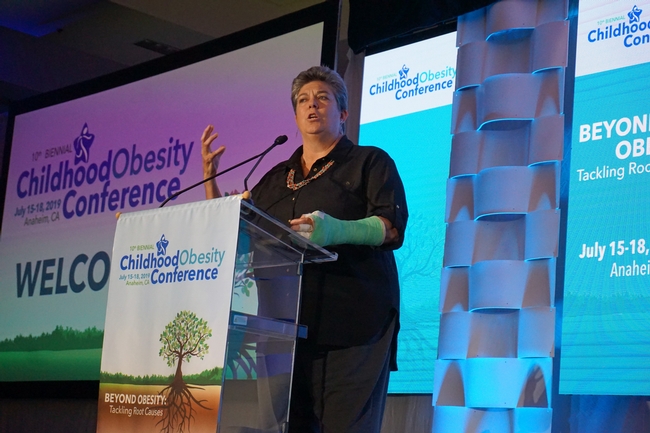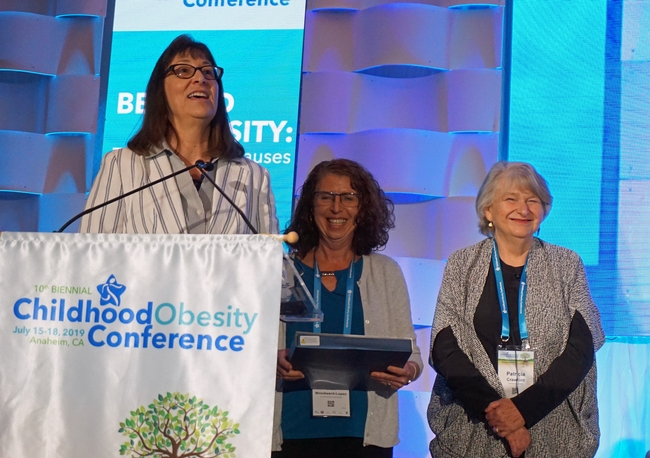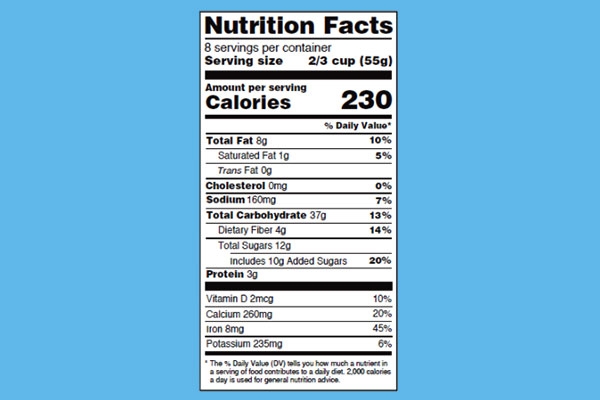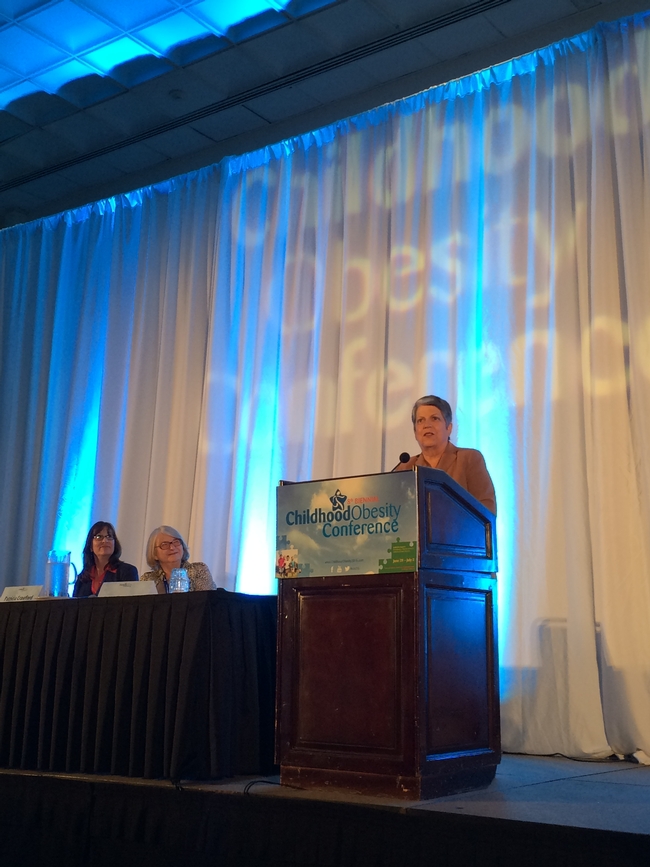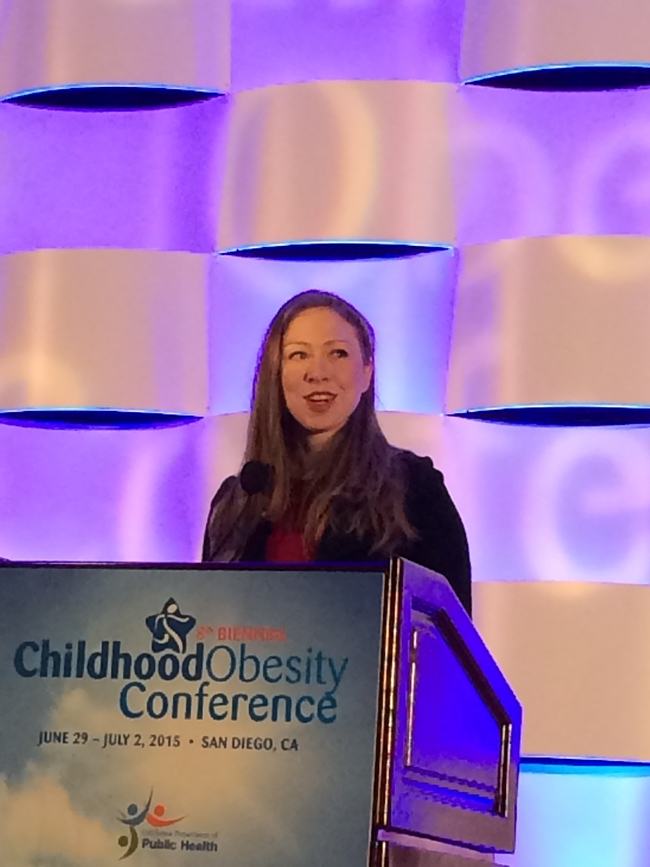Posts Tagged: Patricia Crawford
Children are getting healthier, but the obesity crisis is not over
Real progress has been made in tackling the epidemic of childhood obesity since the first California Childhood Obesity Conference was held 20 years ago, but there is more work to be done.
“Collectively, we have come so far,” UC Nutrition Policy Institute Director Lorrene Ritchie told an audience of 1,025 public health, nutrition education, research, and other professionals at the event in Anaheim in July 2019. NPI was one of six conference hosts.
In the last 20 years:
- Federal school meal standards have been revised so that the food children eat at school is healthier than the lunches they bring from home.
- Sugar-sweetened beverages are no longer available to students during the school day.
- Foods provided by the Special Supplemental Nutrition Program for Women, Infants and Children (WIC) are healthier and give mothers incentive to breast feed their babies.
- The Supplemental Nutrition Assistance Program (SNAP) education component is now linked to policy, systems and environmental changes.
- The Child and Adult Care Food Program now provides healthier meals and snacks to children in childcare centers and homes across the country.
The average quality of the diet of American children has improved, but the rate of childhood obesity in the United States is still too high.
According to the Centers for Disease Control and Prevention, 18.5% of U.S. children and adolescents 2 to 19 years old are obese – about 13.7 million youth in all. The rates trend higher in minority communities, with 25.8% of Latinx youth and 22% of African American youth obese. Obesity is also more prevalent among children in families with low incomes.
Obesity, which is defined in children as a body mass index at or above the 95th percentile of CDC growth charts, is associated with poorer mental health status, reduced quality of life, and increased prevalence of diabetes, heart disease, stroke and some types of cancer.
The vice president of UC Agriculture and Natural Resources, Glenda Humiston, pledged the organization's commitment to community health and wellbeing at the Childhood Obesity Conference. UC ANR is the umbrella organization of the Nutrition Policy Institute, UC CalFresh Healthy Living, UC Cooperative Extension, 4-H Youth Development, the UC Master Gardener Program and the California Naturalist Program, among others.
“Going forward, solutions to the obesity epidemic are multidisciplinary,” Humiston said. “NPI does world class work in conducting research to influence nutrition policy. We need to harness 4-H. Master Gardeners are increasingly focusing on edible gardens. CalNat is getting people out into nature. We are finding synergies in community wellness.”
Humiston has dedicated UC ANR resources to finding and implementing solutions to the obesity crisis.
“I'm looking forward to working with all of you – public and private organizations – to design a way to move forward,” she said.
The opening keynote presentation at the conference featured Patricia Crawford, NPI's Senior Director of Research emeritus, a pioneer in addressing the growing problem of childhood obesity during her long career. Beginning in the 1970s, she recognized that childhood obesity was on the rise and launched several studies to search for the causes and potential solutions.
In one study, Crawford followed a group of 9-year-old African American girls over a period of 10 years to determine why these youth were growing up heavier than other adolescents.
“Finally, we began to get some answers,” Crawford said. “We learned obesity wasn't the children's fault. They were living in environments that made the unhealthy choice cheaper and easier to find. It's so unfair for people who have fewer resources. Health disparities has to be the No. 1 thing we are working on to address chronic disease rates in this country.”
“The solution to obesity is prevention. It's cheaper and more effective than treatment,” Crawford continued. “Healthy food is a taste that is easy to acquire if it is not preempted by junk food.”
Crawford said she honed in on the best strategies for prevention by actively listening to people struggling to make healthy choices
“There is a chasm between research and community,” Crawford said. “We have to get people together from the research level and the policy level with folks on the ground. We need to learn from people.”
UC's Pat Crawford weighs in on childhood obesity
Today marks the start of the 9th Biennial Childhood Obesity Conference. Since it's founding 18 years ago by UC ANR Specialist Pat Crawford, it has grown from a small gathering of California researchers, educators, and health care professionals to the nation's largest gathering on the topic of pediatric obesity/overweight.
So today seems the perfect time to revisit a 2015 conversation with Rose Hayden-Smith, UC's Food Observer, and Crawford, now the Senior Director of Research at UC ANR's Nutrition Policy Institute. As Pat stated in her interview—
“Not changing is risky. The United States – along with Mexico – has the highest obesity rates in the industrialized world. With these extraordinarily high obesity rates, we are on a path toward ever-rising chronic disease rates including not just diabetes, but also heart disease and some cancers, increasing health care costs and reducing productivity.
Even more alarming, is a little known fact that 23 percent of the adolescents in this country currently have pre-diabetes or diabetes as measured by actual blood tests in our largest national study of health (NHANES). Something is seriously wrong in a society such as ours where so many children are growing up with such a high risk of preventable disease.”
You can read the complete interview at the UC Food Observer. You'll also find a recent story about the 45 youth advocates from organizations around California joining this year's conference to bring the voices of youth to this vital conversation.
As Americans struggle with obesity and diabetes, help is on the way
The iconic black-and-white Nutrition Facts label for packaged foods in the U.S. is getting its first makeover in two decades. The federal government's decision last month to update the food label means that for the first time, beginning in 2018, labels will list how much added sugar is in a product.
The decision, reflecting the latest science, will be felt well beyond the label. University of California food experts praised the labeling changes and offered six key takeaways.
1. Listing added sugar is the most important label change.
The new label will list the amount of added sugar in a product, both in grams and as a percentage of the daily recommended allowance.
“That's key,” said Laura Schmidt, a UC San Francisco professor of health policy and UC Global Food Initiative subcommittee member. “That will be really helpful for consumers.”
Added sugar – any sugar added in the preparation of foods such as table sugar, high fructose corn syrup and others – can be found in hundreds of products such as cereal, yogurt, pasta sauce and salad dressing. But the biggest source is sugar-sweetened beverages, which account for nearly half of Americans' intake of added sugar.
One 20-ounce soda will take you over the recommended amount of sugar for an entire day,” said Pat Crawford, senior director of research for the Nutrition Policy Institute of UC's Division of Agriculture and Natural Resources. “The new label will allow people to reasonably see what they're doing when they're consuming high-sugar products.”
The current label lumps added sugar with naturally occurring sugars in the foods themselves, which is a deceptive practice, said Dr. John Swartzberg, a UC Berkeley clinical professor emeritus and editorial board chair of the UC Berkeley Wellness Letter. Listing added sugar “will hopefully guide people away from consuming products with a lot of added sugar,” he said.
2. Americans need to consume less sugar.
More than one out of three adults in the U.S. is obese. Nearly half of U.S. adults have prediabetes or diabetes, raising their risk of heart attacks, kidney failure, blindness and amputations. Among U.S. children, more than 1 in 6 is obese, and diabetes and prediabetes rates are rising. Amid these alarming statistics, there's a growing concern about too much added sugar in diets.
“It's important to give the public the information they need in order to modify their diets,” Crawford said. “We are now finding significant effects on diabetes and heart disease rates for those who regularly consume sugary beverages. A large study of women over an eight-year period found that the risk of diabetes among women who consumed one or more servings of sugar-sweetened beverages per day was nearly double the risk among women who consumed less than one serving per month. Further, drinking one 12-ounce soda a day increases the risk of cardiovascular mortality by almost one-third.”
Crawford noted that the new federal dietary guidelines for the first time recommend limiting added sugars in the diet to no more than 10 percent of one's daily calories.
“The average amount of added sugar in the American diet is more than 20 teaspoons per day, nearly all of which is added to our foods during processing,” Crawford said. “Since about half of this sugar comes in the form of beverages, we have to rethink our beverage choices. Water should be the beverage of choice.”
Consumers will be very surprised to see the percentage of daily value of added sugar in one soda drink, said Michael Roberts, executive director of the UCLA Resnick Program for Food Law and Policy and UC Global Food Initiative subcommittee member. “Time will tell whether this information changes human behavior, i.e., consuming less soda. To be fair, sugar pops up everywhere, not just soda, so the impact that these changes will have on consumers and manufacturers will be interesting to watch.”
3. Expect manufacturers to make product changes.
When the federal government required that manufacturers add trans fat information on the label a decade ago, the food industry responded by marketing more products with lower trans fats, Crawford said.
“Trans fats are now not allowed to be added to foods during processing, but it all began with labeling,” Crawford said. “We're going to see some big shifts in the marketplace with products lower in sugars such as cereals, yogurts, spaghetti sauces and beverages, of course. We can look forward to recipe reformulation, which will make products more competitive. It's a great first step for reducing sugar consumption. In preparation for the new labels, manufacturers are working on creating products with lower levels of added sugars.”
For manufacturers, the trick will be to keep food tasting good to consumers while reducing sugar, Roberts said. “Other large manufacturers will pursue new products that are not heavy on added sugars,” Roberts said. “For example, Coke and Pepsi sell bottled water.”
“There is a push to at least re-size products,” Schmidt added. “There certainly will be an effort for front-of-package labeling that says ‘low sugar.'”
4. The new label could lead to regulations limiting sugar.
“Including added sugar on the label will be a game-changer for those debates about what is a healthy diet for people in the federal food-assistance programs,” said Schmidt, lead investigator on the UCSF-led SugarScience research and education initiative. “Once you've got added sugar on the label along with a daily reference value, policymakers will be in the position to set standards for the quantity of added sugar allowed in school lunches and other federal food programs.”
Changes like this have happened before, Schmidt noted. “In the U.K., the government said salt consumption is way too high and mandated that packaged food manufacturers reduce the amount of sodium in their products. It worked like a charm – they just gradually reduced the excess salt in foods to everyone's benefit.”
5. The new label makes changes beyond sugar.
The new label also will list more realistic serving sizes and will list calories in a larger and bolder font. “This will help people assess how many calories they are actually consuming,” Swartzberg said. (View a complete list of label changes here.)
6. Further steps could help consumers.
While praising the label changes, UC experts say further steps could help consumers make more informed choices:
- Adding front-of-package labeling that states whether the product is high in sugar, salt or fat: “This banner on the front of packages would make it simple for a consumer to see whether a food is healthy or whether it has ingredients that contribute to risk of heart disease, stroke, obesity or cancer,” Crawford said.
- Having food vendors add “stoplight” stickers: “There is the stoplight idea of labeling products with green, yellow and red stickers – green for the low-sugar products and red for the high-sugar ones,” offered Schmidt.
- Promoting environmentally sustainable food practices: “(We should) consume more plant-based foods and less meat,” Swartzberg suggested.
- Increasing research: “The label change is not enough: Further research, education and sound policies will need to be developed to motivate more healthy eating,” Roberts said.
Experts combine research with policy to reduce childhood obesity
It was the first time a UC president has taken part in the long-running and nationally recognized gathering, noted the director of UC Agriculture and Natural Resources' Nutrition Policy Institute (NPI), Lorrene Ritchie.
“I think it demonstrates her commitment to the Global Food Initiative and the work we do at UC ANR,” Ritchie said.
During her remarks, Napolitano said it was fitting for her to speak at the conference as it coincided with the one-year anniversary of the Global Food Initiative, a sweeping effort involving all UC campuses and UC ANR that was inspired by many of the same concerns addressed by conference participants.
“As we meet here in San Diego today, a billion people — most but not all of them in the developing world — suffer from chronic hunger or serious micronutrient deficiencies,” Napolitano said. “Another half billion — primarily in the industrialized nations of the world, like the United States — suffer from obesity.”
Since the biennial conference's inception, Patricia Crawford, UC ANR Cooperative Extension nutrition specialist, and other members of NPI have been involved in its planning. Crawford announced she is “passing the baton” to Ritchie to guide the conference moving forward.
More than 1,700 nutritionists and other experts on children's health attended the San Diego gathering June 29 – July 2. In addition to the NPI, the conference was hosted by the California Department of Public Health, California Department of Education, the California Endowment and Kaiser Permanente.
NPI hosted a preconference workshop on June 29 to bridge the gap between research and policy regarding the federal nutrition assistance programs and the Dietary Guidelines, which reach more Americans than any other nutrition policy.
“The preconference session provided a rare opportunity for policymakers and administrators, nutrition researchers, advocates, and funders to sit together to identify today's key policy issues and propose research to inform future policy debates and developments,” said Kenneth Hecht, NPI director of policy. “Participants also focused on another extremely important question: How to improve communications in both directions between researchers and policymakers.”
At the opening plenary session, Chelsea Clinton, vice-chair of The Clinton Foundation, talked about projects her family's foundation work to improve children's health and literacy.
“Childhood obesity is a national security challenge. The Joint Chiefs of Staff said that very clearly in 2013,” Clinton said. “In New York City, where I live, the New York City Fire Department and Police Department have said they are worried they won't be able recruit enough people to fill their ranks if obesity rates continue.”
To help address the problem, the Clinton Foundation along with the American Heart Association established the Alliance for a Healthier Generation 10 years ago. Because of the program, nearly 300 California schools have made changes significantly reducing overweight among children.
“Grateful to all @ObesityConffor for a great morning talking about @HealthierGenand for everything you do to help children be healthy!#COC15,” Clinton tweeted after her presentation.
During a workshop session, NPI's Ritchie and other panelists discussed the importance of policies and standards for healthy alternatives to sugar-sweetened beverages for children in childcare settings. Crawford and other panelists presented data on childhood obesity trends and racial/ethnic disparities in California and discussed the health and financial consequences. They also addressed the cost-effectiveness of national and state excise taxes on sugar-sweetened beverages and labels to inform consumers of the health risks of consuming sugary drinks.
Hecht also moderated a panel on local and national initiatives that are linking farm fresh produce to food bank recipients. NPI researcher Elizabeth Campbell, who participated in the discussion with a local farmer, a food bank employee and a public health anti-hunger advocate, said food banks should have policies to guide the nutritional quality of their inventory.
During the closing plenary, First Lady Michelle Obama sent video greetings to the Childhood Obesity Conference attendees to praise them for their work and encourage them to continue to fight to protect children's health.
PowerPoint presentations from the conference are available online. Photos and postconference information can be seen on Facebook and Twitter and with the hashtag #COC15.
Sugary drinks are hiding under a 'health halo'
Researchers investigated the growing and often confusing list of supplements added to the drinks. In most cases, they found, the beverages provide little or no health benefits, and might be dangerous.
"Despite the positive connotation surrounding energy and sports drinks, these products are essentially sodas without the carbonation," said Patricia Crawford, UC Cooperative Extension specialist in the Department of Nutritional Sciences and Toxicology at UC Berkeley.
The study looked at 21 popular drinks touted by manufacturers as "health and performance enhancing." In addition to sugar, caffeine, non-caloric sweeteners, sodium, vitamins and minerals, some drinks included the supplements guarana, ginseng, taurine, gingko biloba and ginger extract. Of the five herbal supplements, only ginger extract is classified as "likely safe" for children, Crawford said.
Because they contain caffeine, marketers promote the beverages as improving energy, concentration, endurance and performance. The study, however, documented harmful effects, such as increasing stress, nervousness, anxiety, headaches, insomnia, tremors, hallucinations and seizures.
"(Drink manufacturers') health marketing claims are the 21st Century equivalent of selling snake oil," said Harold Goldstein of the California Center for Public Health Advocacy, which commissioned the study.
The full report is at http://www.publichealthadvocacy.org/healthhalo.html.



